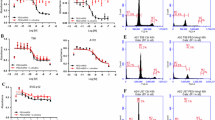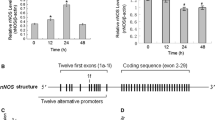Abstract
Hereditary argininemia manifests as neurological disturbance and mental retardation, features not observed in other amino acidemias. The cytotoxic effect of a high concentration of L-arginine (L-Arg) was investigated using NB9 human neuroblastoma cells (NB9), which express neuronal nitric oxide synthase (nNOS). When the concentration of L-Arg in the medium increased from 50 µM to 2 mM after incubation for 48 hr, the intracellular concentration of L-Arg increased from 68.0 ± 1 pmol/106 cells to 1310.0 ± 5 pmol/106 cells and that of L-citrulline (L-Cit) from undetectable levels to 47.1 ± 0.2 pmol/106 cells (mean ± SD of three independent analyses). This increase in intracellular L-Arg levels caused a decrease in NOS activity by approximately 71%. Flow cytometric analysis showed that reactive oxygen species (ROS) are produced in NB9 exposed to 2 mM L-Arg. The production of ROS was abolished by a NOS inhibitor, NG-nitro-L arginine-methylester. Production of ROS was also observed when NB9 were treated with L-Cit for 48 hr. To investigate the effect of L-Cit on the activity of NOS, a kinetic study on nNOS was conducted using cellular extracts from NB9. The apparent Km value of nNOS for L-Arg was 8.4 µM, with a Vmax value of 8.2 pmol/min/mg protein. L-Cit competitively inhibited NOS activity, as indicated by an apparent Ki value of 65 nM. These results suggest that L-Cit formed by nNOS in L-Arg-loaded neuronal cells inhibits NOS activity and nNOS in these L-Arg-loaded cells functions as a NADPH oxidase to produce ROS, which may cause neurotoxicity in argininemia.





Similar content being viewed by others
References
Brusilow SW, Horwich AL. (1989) Urea cycle enzymes. In: Scriver CR, Sly WAS, Beaudet AL, Valle D (eds). The Metabolic Basis of Inherited Disease. Mc-Graw-Hill, New York, pp. 629–663.
Uchino T, Snyderman SE, Lambert M, et al. (1995) Molecular basis of phenotypic variation in patients with argininemia. Hum. Genet. 96: 255–260.
Marescau B, De Deyn PP, Lowenthal A, et al. (1990) Guanidino compound analysis as a complementary diagnostic parameter for hyperargininemia: Follow-up of guanidino compound levels during therapy. Pediatr. Res. 27: 297–303.
Haraguchi Y, Takiguchi M, Amaya Y, Kawamoto S, Matsuda I, Mori M. (1987) Molecular cloning and nucleotide sequence of cDNA for human liver arginase. Proc. Natl. Acad. Sci. U.S.A. 84: 412–415.
Takiguchi M, Haraguchi Y, Mori M. (1988) Human liver-type arginase gene: Structure of the gene and analysis of the promoter region. Nucl. Acids Res. 16: 8789–8802.
Sparkes RS, Dizikes GJ, Klisak I, et al. (1986) The gene for human liver arginase (ARG1) is assigned to chromosome band 6q23. Am. J. Hum. Genet. 39: 186–193.
Haraguchi Y, Aparicio JM, Takiguchi M, et al. (1990) Molecular basis of argininemia. Identification of two discrete frame-shift deletions in the liver-type arginase gene. J. Clin. Invest. 86: 347–350.
Uchino T, Haraguchi Y, Aparicio JM, et al. (1992) Three novel mutations in the liver-type arginase gene in three unrelated Japanese patients with argininemia. Am. J. Hum. Genet. 51: 1406–1412.
Bredt DS, Ferris CD, Snyder SH. (1992) Nitric oxide synthase regulatory sites. Phosphorylation by cyclic AMP-dependent protein kinase, protein kinase C, and calcium/calmodulin protein kinase: Identification of flavin and calmodulin binding sites. J. Biol. Chem. 267: 10976–10981.
Yu Y, Terada K, Nagataki A, Takiguchi M, Mori M. (1995) Preparation of recombinant argininosuccinate synthetase and argininosuccinate lyase: Expression of the enzymes in rat tissues. J. Biochem. 117: 952–957.
Urata Y, Yamamoto H, Goto S, et al. (1996) Long exposure to high glucose concentration impairs the responsive expression of γ-glutamylcysteine synthetase by interleukin-1β and tumor necrosis factor-α in mouse endothelial cells. J. Biol. Chem. 271: 15146–15152.
Sen R, Baltimore D. (1986) Multiple nuclear factors interact with the immunoglobulin enhancer sequences. Cell 46: 705–716.
Galea E, Feinstein DL, Reis DJ. (1992) Induction of calcium-independent nitric oxide synthase activity in primary rat glial cultures. Proc. Natl. Acad. Sci. U.S.A. 89: 10945–10949.
Bass DA, Parce JW, Dechatelet LR, Szejda P, Seeds MC, Thomas M. (1983) Flow cytometric studies of oxidative product formation by neutrophils: a graded response to membrane stimulation. J. Immunol. 130: 1910–1917.
Gong J, Traganos F, Darzynkiewicz Z. (1994) A selective procedure for DNA extraction from apoptotic cells applicable for gel electrophoresis and flow cytometry. Anal. Biochem. 218: 314–319.
Bredt DS, Hwang PM, Snyder SH. (1990) Localization of nitric oxide synthase indicating a neural role for nitric oxide. Nature 347: 768–770.
Dawson TM, Bredt DS, Fotuhi M, Hwang PM, Snyder SH. (1991) Nitric oxide synthase and neuronal NADPH diaphorase are identical in brain and peripheral tissues. Proc. Natl. Acad. Sci. U.S.A. 88: 7797–7801.
Greenwood MT, Guo Y, Kumar U, Beauséjours S, Hussain SNA. (1997) Distribution of protein inhibitor of neuronal nitric oxide synthase in rat brain. Biochm. Biophys. Res. Commun. 238: 617–621.
Huang PL, Dawson TM, Bredt DS, Snyder SH, Fishman MC. (1993) Targeted disruption of the neuronal nitric oxide synthase gene. Cell 75: 1273–1286.
Gaily JA, Montague PR, Reeke GN Jr, Edelman GM. (1990) The NO hypothesis: possible effects of a short-lived, rapidly diffusible signal in the development and function of the nervous system. Proc. Natl. Acad. Sci. U.S.A. 87: 3547–3551.
Bredt DS, Hwang PM, Glatt CF, Lowenstein C, Reed RR, Snyder SH. (1991) Cloned and expressed nitric oxide synthase structurally resembles cytochrome P-450 reductase. Nature 351: 714–718.
Heinzel B, John M, Klatt P, Bohme E, Mayer B. (1992) Ca2+/calmodulin-dependent formation of hydrogen peroxide by brain nitric oxide synthase. Biochem. J. 281: 627–630.
Pou S, Pou WAS, Bredt DS, Snyder SH, Rosen GM. (1992) Generation of superoxide by purified brain nitric oxide synthase. J. Biol. Chem. 267: 24173–24176.
Culcasi M, Lafon-Cazal M, Pietri S, Bockaert J. (1994) Glutamate receptors induce a burst of superoxide via activation of nitric oxide synthase in arginine-depleted neurons. J. Biol. Chem. 269: 12589–12593.
Simmons ML, Murphy S. (1992) Induction of nitric oxide synthase in glial cells. J. Neurochem. 59: 897–905.
Jiang K, Kim S, Murphy S, Song D, Pastuszko A. (1996) Effect of hypoxia and reoxygenation on regional activity of nitric oxide synthase in brain of newborn piglets. Neurosci. Lett. 206: 199–203.
Hall AV, Antoniou H, Wang Y, et al. (1994) Structural Organization of the human neuronal nitric oxide synthase gene (NOS1). J. Biol. Chem. 269: 33082–33090.
Iwanaga M, Mori K, Iida T, et al. (1998) Nuclear factor kappa b dependent induction of gamma glutamylcysteine synthetase by ionizing radiation in T98G human glioblastoma cells. Free Radic. Biol. Med. 24: 1256–1258.
Karin M. (1995) The regulation of AP-1 activity by mitogen-activated protein kinases. J. Biol. Chem. 270: 16483–16486.
Acknowledgments
This work was supported in part by a grant-in-aid from the Ministry of Education, Science and Culture of Japan and The Chiyoda Life Social Welfare Foundation.
Author information
Authors and Affiliations
Corresponding author
Additional information
Communicated by E. Buetler.
Rights and permissions
About this article
Cite this article
Todoroki, S., Goto, S., Urata, Y. et al. High Concentration of L-Arginine Suppresses Nitric Oxide Synthase Activity and Produces Reactive Oxygen Species in NB9 Human Neuroblastoma Cells. Mol Med 4, 515–524 (1998). https://doi.org/10.1007/BF03401756
Accepted:
Published:
Issue Date:
DOI: https://doi.org/10.1007/BF03401756




